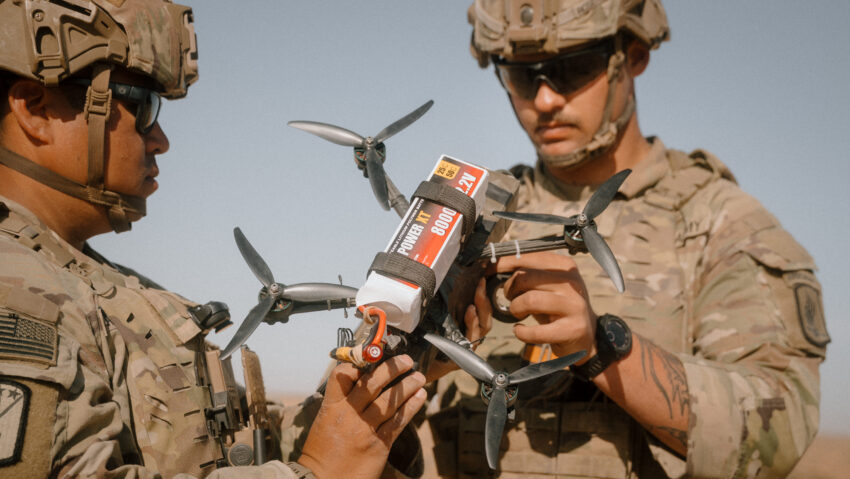US Army Sgt. Jacob Rosencrantz, right, and Sgt. 1st Class Elio Sauceda, paratroopers assigned to the 173rd Airborne Brigade power on a first-person view drone during exercise African Lion 2025 (AL25), at Ben Ghilouf Training Area, Tunisia, April 27, 2025. (US Army/Sgt. Mariah Y. Gonzalez)
WASHINGTON — Defense Secretary Pete Hegseth is directing every US Army squad to be armed with small, one-way attack drones by the end of fiscal 2026, while also enabling troops to modify small drones as necessary in the field as part of a push to break through policy and acquisition barriers.
“While global military drone production skyrocketed over the last three years, the previous administration deployed red tape,” Hegseth wrote in the Unleashing US Military Drone Dominance memo dated today. “US
units are not outfitted with the lethal small drones the modern battlefield requires.”
Continued Hegseth, “The directives… support our industrial base, reform acquisition, and field new technology for the warfighter. Lethality will not be hindered by self-imposed restrictions, especially when it comes to harnessing technologies we invented but were slow to pursue.”
That new Pentagon memo follows an early June executive order from the White House dubbed, “Unleashing American Drone Domination” focusing more broadly on commercial UAS. Hegseth’s directive, though, is aimed at drilling down on what that means for the Department of Defense.
For starters, Hegseth rescinds several DoD policies including:
- The 2022 “Exception to Policy Requirement for Blue Small Unmanned Aircraft Systems” memo that outlines circumstances where a Governmentwide Commercial Purchase Card (GPC) can be used to purchase sUAS; and
- A 2021 memo that outlines the guidance for procedures for the operation and procurement of UAS to implement Section 848 of the 2020 National Defense Authorization Act that, in part, prohibited the procurement and operation of drones by certain foreign entities.
“I am rescinding restrictive policies that hindered production and limited access to these vital technologies, unleashing the combined potential of American manufacturing and warfighter ingenuity. I am delegating authorities to procure and operate drones from the bureaucracy to our warfighters,” he added.
One military official told Breaking Defense that those two policies made it “overly restrictive and burdensome” for the services to procure UAS, and in some cases exceeded the requirements of NDAA 848.
Even after the 2023 American Security Drone Act provided more exceptions for DoD to procure drones, the Biden administration did not change those policies that remained more restrictive.
Hegseth also directs the Chairman of the Joint Chiefs of Staff, Gen. Dan Caine, to revise the Joint Unmanned Aircraft Systems Minimum Training Standards (3255.01) so that it excludes Group 1 and 2 drones, while also revising just what drones fit into the Group 3 — a weight that spans 56lbs all the way up to 1,319 lbs.
The military official explained that this “outdated policy” — penned in 2009 and updated in 2011 — sets joint training requirements based on the group or weight of the UAS.
“As technology, mission complexity, lethality, and proliferation of UAS are moving so rapidly, we must develop new standards,” the military official added. “The directive for the CJCS to initiate a revision ensures there is not a policy gap in standards while it’s updated.”
A Drone For Every Squad
As for troops in the field and in combat, Hegseth wants them to have the ability to modify drones as necessary to meet “mission requirements.” Additionally, each Army squad needs to be outfitted with small, first-person view (FPV) drones by October 2026.
This FPV directive will be a shift of the Army that is working through acquisition plans while also figuring out how to use the small drones in combat.
Today, the service is acquiring FPVs via a mix of smaller, commercial off-the-shelf buys and also 3D printing them. However, it is expected to move out with an official program dubbed the Purpose-Built, Attritable Systems (PBAS), and earlier this month posted a call for companies that can produce small drones under $2,000 as part of a new requirement to immediately field up to 10,000 such weapons within 12 months.
Meanwhile, units throughout the Army are working though how to best organize to use FPV drones. Soldiers with the 1st Armored Brigade Combat Team, 3rd Infantry Division, for example, recently participated in Combined Resolve 25-02 in Hohenfels, Germany.
As part of the training exercise, the previous RQ-7B Shadow platoon morphed into a FPV platoon.
“We kind of want to look at FPVs as a type of ammunition, where we try to look at it in terms of providing a unit with a UBL [unit basic load],” Col. Timothy Gatlin, the 3rd IDs deputy commanding officer for maneuver, recently told Breaking Defense. “What’s going to be necessary? How many FPVs do you need for a movement to contact? What do you need for a deliberate attack? Much like we look at mortar, ammunition, cannon and rocket artillery, I think that’s how we’re looking at it inside of the 3rd Infantry Division.”
Click this link for the original source of this article.
Author: Ashley Roque
This content is courtesy of, and owned and copyrighted by, https://breakingdefense.com and its author. This content is made available by use of the public RSS feed offered by the host site and is used for educational purposes only. If you are the author or represent the host site and would like this content removed now and in the future, please contact USSANews.com using the email address in the Contact page found in the website menu.








